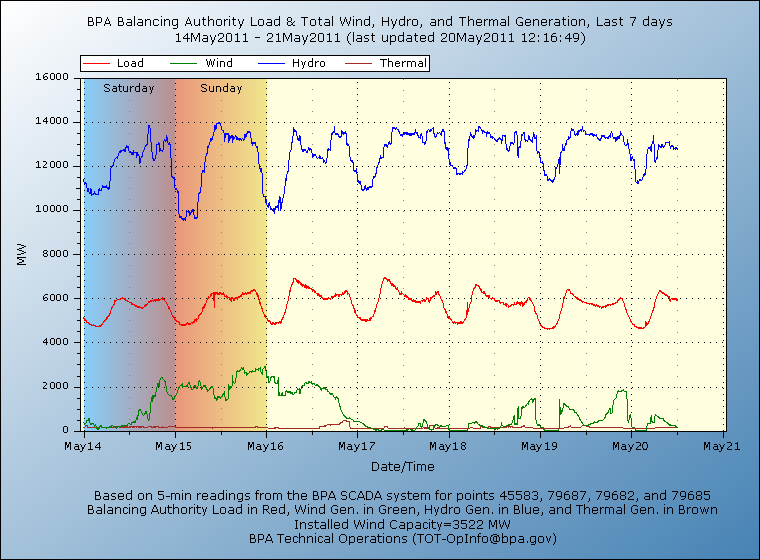forum
library
tutorial
contact

Northwest Power Surplus may Halt Wind Energy
by Rocky BarkerIdaho Statesman, May 14, 2011
|
the film forum library tutorial contact |

|
Northwest Power Surplus may Halt Wind Energy
by Rocky BarkerIdaho Statesman, May 14, 2011 |
 "This is really not about wind -- it's a hydro issue," said Rachel Shimshak, executive director of Renewable Northwest, which pushes alternative energy. "Wind adds to this, but the great majority of this is a water issue."
"This is really not about wind -- it's a hydro issue," said Rachel Shimshak, executive director of Renewable Northwest, which pushes alternative energy. "Wind adds to this, but the great majority of this is a water issue."
The BPA markets about one-third of the electricity consumed in the region. It sells the power produced from 31 federally owned dams on the Columbia River and its tributaries and owns and operates 15,000 miles of high-voltage transmission lines.
About 15 percent of Idaho's electricity comes from BPA, through rural electrical cooperatives and municipal utilities such as the one in Idaho Falls.
These consumer co-ops see themselves caught in the middle of a shift in the energy market, and they hope the issue is settled amicably.
"When wind developers don't want to shut down, that hurts fish and costs us money," said Will Hart, executive director of the Idaho Consumer-owned Utilities Association.
The issue is similar to the fight Idaho Power and other investor-owned utilities are having with wind developers in Idaho. Wind generation in the Pacific Northwest has grown from around 500 megawatts in 2006 to more than 6,000 megawatts today.
That's more than twice the capacity of the four lower Snake River dams that have been at the center of the salmon debate for the past decade. It's enough power for more than two cities the size of Seattle.
"We're all looking for solutions to integrate wind," said Lisa Grow, senior vice president of power supply for Idaho Power Co. "We're sympathetic to where BPA is coming from on this issue, and we're working with them to identify similarities and/or differences in our situations."
One difference is that BPA has encouraged wind developers. Most of the year, wind power goes hand in glove with a hydroelectric power system, Mainzer said.
"We've kind of bent over backwards to get the wind on the system," he said.
But Idaho Power has shown less support to wind developers, fearing it would be forced to turn off less-expensive power sources like coal plants when the wind is blowing.
"Not all megawatts are created equal, and integrating wind energy into the electrical grid requires additional resources to quickly react to moment-to-moment changes in this resource," Grow said.
Renewables like wind are going to cost consumers less over time for the same reason that hydroelectric power has been relatively cheap, Shimshak said. "The fuel is free."
But managing an electricity grid with many more intermittent sources of power will take more coordinated management, such as "smart grid" technology that uses computers to increase energy-efficiency. Demand-side management programs that encourage customers to use power when it's bountiful and cheap also will help, Shimshak said.
More transmission lines, such as the 300-mile proposed line between Idaho and the Columbia River in Oregon also will ease the bottleneck.
"Nobody says this is not a challenge," Shimshak said. "I think the best approach is to have a lot of tools in the tool box."
Overgeneration Announcement related to graphic.To safeguard salmon and steelhead and assure reliable energy delivery during these unusually high seasonal river flows, BPA has taken the following measures, which it took as a last resort and had been working to avoid. BPA will update this site at 9 a.m. and 3 p.m., Monday through Friday.
[May 20, 9 a.m.] BPA temporarily limited the energy output of regional generators, including wind generators, from 11 p.m. May 19 until 5 a.m. May 20. During that six hour period, approximately 600 to 1,200 megawatts per hour of wind generation, totaling about 5,300 megawatt hours, were impacted.
[May 19, 3 p.m.] No current limits on generation
[May 19, 9 a.m.] BPA temporarily limited the energy output of regional generators, including wind generators, from 11 p.m. May 18 until 5 a.m. May 19. During that six hour period, slightly less than 1,000 megawatts per hour of wind generation, totaling about 5,700 megawatt hours, were impacted.
[May 18, 3 p.m.] No current limits on generation
[May 18, 9 a.m.] BPA temporarily limited the energy output of regional generators, including wind generators, from midnight until 5 a.m. May 18. Approximately 200-350 megawatts of wind generation per hour, totaling about 1,400 megawatt hours, were impacted.
learn more on topics covered in the film
see the video
read the script
learn the songs
discussion forum
